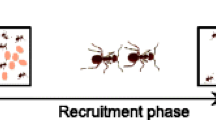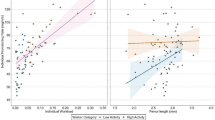Abstract
Certain groups of organisms are capable of improving their collective performance with experience. In a recent study, we demonstrated that, over successive emigrations, colonies of the ant Temnothorax albipennis are able to improve their collective performance by reducing the time taken to complete an emigration (Langridge et al., Behav Ecol Sociobiol 56:523–529, 2004). In this paper, by recording the performance of individually marked workers during repeated emigrations, we were able to analyse some of the ways in which time gains are achieved. We found that: (1) those transporters that also transported in the preceding emigration began to transport earlier in the current emigration and, in the majority of emigrations, transported more items than those transporters that had not transported in the preceding emigration; (2) the time that elapsed before the first item was transported into the new nest reduced over successive emigrations, and this first item was, in the majority of emigrations, carried by a transporter that had also transported in the preceding emigration; (3) the number of adults that were transported reduced over successive emigrations. Our results strongly suggest that the behaviour of transporters that also transported in a preceding emigration may be modified as a result of their experience and that, consequently, their efforts in the next emigration make a major contribution to the improved performance of the colony as a whole.







Similar content being viewed by others

References
Abraham M, Pasteels JM (1980) Social behaviour during nest-moving in the ant Myrmica rubra L. (Hym. Form.). Insect Soc 27:127–147
Beshers SN, Fewell JH (2001) Models of division of labor in social insects. Annu Rev Entomol 46:413–440
Beshers SN, Robinson GE, Mittenthal J (1999) Response thresholds and division of labor in insect colonies. In: Detrain C, Deneubourg J-L, Pasteels JM (eds) Information processing in social insects. Birkhauser Verlag, Basel, pp 115–139
Camazine S, Deneubourg J-L, Franks NR, Sneyd J, Theraulaz G, Bonabeau E (2001) Self-organization in biological systems. Princeton University Press, Princeton, NJ
Carlin NF, Johnston AB (1984) Learned enemy specification in the defense recruitment system of an ant. Naturwissenschaften 71:156–157
Corning WC, Von Burg R (1973) Protozoa. In: Corning WC, Dyal JA, Willows AOD (eds) Invertebrate learning: protozoans through annelids. Plenum, New York, pp 49–122
Deneubourg J-L, Goss S, Pasteels JM, Fresneau D, Lachaud JP (1987) Self-organization mechanisms in ant societies (II): learning in foraging and division of labor. In: Pasteels JM, Deneubourg J-L (eds) From individual to collective behaviour in social insects. Birkhauser Verlag, Basel, pp 177–196
Drea CM (2006) Studying primate learning in group contexts: tests of social foraging, responses to novelty, and cooperative problem solving. Methods 38:162–177
Ellis APJ, Hollenbeck JR, Ilgen DR, West BJ, Porter COLH, Moon H (2003) Team learning: collectively connecting the dots. J Appl Psychol 88:821–835
Franks NR, Sendova-Franks AB (2000) Queen transport during ant colony emigration: a group-level adaptive behaviour. Behav Ecol 11:315–318
Franks NR, Pratt SC, Mallon EB, Britton NF, Sumpter DJT (2002) Information flow, opinion polling and collective intelligence in house-hunting social insects. Phil Trans R Soc Lond B 357:1567–1583
Franks NR, Mallon EB, Bray HE, Hamilton MJ, Mischler TC (2003a) Stategies for choosing between alternatives with different attributes exemplified by house-hunting ants. Anim Behav 65:215–223
Franks NR, Dornhaus A, Fitzsimmons JP, Stevens M (2003b) Speed versus accuracy in collective decision making. Proc R Soc Lond B 270:2457–2463
Howard JJ, Henneman ML, Cronin G, Fox JA, Hormiga G (1996) Conditioning of scouts and recruits during foraging by a leaf-cutting ant, Atta colombica. Anim Behav 52:299–306
Immelmann K, Beer C (1992) A dictionary of ethology. Harvard University Press, Cambridge, MA
Johnson RA (1991) Learning, memory, and foraging efficiency in two species of desert seed-harvester ants. Ecology 72:1408–1419
Langridge EA, Franks NR, Sendova-Franks AB (2004) Improvement in collective performance with experience in ants. Behav Ecol Sociobiol 56:523–529
Lewis LA, Schneider SS (2000) The modulation of worker behavior by the vibration signal during house hunting in swarms of the honeybee, Apis mellifera. Behav Ecol Sociobiol 48:154–164
Lewis LA, Schneider SS, DeGrandi-Hoffman G (2002) Factors influencing the selection of recipients by workers performing vibrating signals in colonies of the honeybee Apis mellifera. Anim Behav 63:361–367
Mallon EB, Pratt SC, Franks NR (2001) Individual and collective decision-making during nest site selection by the ant Leptothorax alibipennis. Behav Ecol Sociobiol 50:352–359
McFarland D (1987) The Oxford companion to animal behaviour. Oxford University Press, Oxford
Meddis R (1984) Statistics using ranks: a unified approach. Basil Blackwell, Oxford
Menzel R (1999) Memory dynamics in the honeybee. J Comp Physiol A 135:323–340
Pearce JM (1999) Animal learning and cognition: an introduction. Psychology Press, Hove, Sussex
Pezon A, Denis D, Cerdan P, Valenzuela J, Fresneau D (2005) Queen movement during colony emigration in the facultatively polygynous ant Pachycondyla obscuricornis. Naturwissenschaften 92:35–39
Pratt SC (2005a) Quorum sensing by encounter rates in the ant Temnothorax albipennis. Behav Ecol 16:488–496
Pratt SC (2005b) Behavioral mechanisms of collective nest-choice by the ant Temnothorax curvispinosus. Insect Soc 52:383–392
Pratt SC, Mallon EB, Sumpter DJT, Franks NR (2002) Quorum sensing, recruitment and collective decision-making during colony emigration by the ant Leptothorax albipennis. Behav Ecol Sociobiol 52:117–127
Roces F, Hölldobler B (1994) Leaf density and a trade-off between load-size selection and recruitment behaviour in the ant Atta cephalotes. Oecologia 97:1–8
Schneirla TC (1943) The nature of ant learning, II. The intermediate stage of segmental maze adjustment. J Comp Psychol 35:149–176
Sendova-Franks AB, Franks NR (1993) Task allocation in ant colonies within variable environments (a study of temporal polyethism: experimental). Bull Math Biol 55:75–96
Sendova-Franks AB, Franks NR (1995a) Spatial relationships within nests of the ant Leptothorax unifasciatus (Latr.). Anim Behav 50:121–136
Sendova-Franks AB, Franks NR (1995b) Division of labour in a crisis: task allocation during colony emigration in the ant Leptothorax unifasciatus (Latr.). Behav Ecol Sociobiol 36:269–282
Siegal S, Castellan NJ (1988) Nonparametric statistics for the behavioural sciences. McGraw-Hill, New York
Sokal RR, Rohlf FJ (1995) Biometry. Freeman, New York
Theraulaz G, Bonabeau E, Deneubourg J-L (1998) Threshold reinforcement and the regulation of division of labour in social insects. Proc R Soc Lond B 265:327–333
Thorpe WH (1963) Learning and instinct in animals. Methuen, London
Trumbo ST, Robinson GE (1997) Learning and task interference by corpse-removal specialists in honey bee colonies. Ethology 103:966–975
Weidenmüller A (2004) The control of nest climate in bumblebee (Bombus terrestis) colonies: interindividual variability and self reinforcement in fanning response. Behav Ecol 15:120–128
Weidenmüller A, Kleineidam C, Tautz J (2002) Collective control of nest climate parameters in bumblebee colonies. Anim Behav 63:1065–1071
Acknowledgement
We wish to thank Antony Aleksiev, Stefanie Berghoff, François-Xavier Dechaume-Moncharmont and Roderich Groβ for constructive comments on this manuscript. The experiment reported in this study complied with the current laws of the UK.
Author information
Authors and Affiliations
Corresponding author
Additional information
Communicated by M. Beekman
Rights and permissions
About this article
Cite this article
Langridge, E.A., Sendova-Franks, A.B. & Franks, N.R. How experienced individuals contribute to an improvement in collective performance in ants. Behav Ecol Sociobiol 62, 447–456 (2008). https://doi.org/10.1007/s00265-007-0472-5
Received:
Revised:
Accepted:
Published:
Issue Date:
DOI: https://doi.org/10.1007/s00265-007-0472-5



